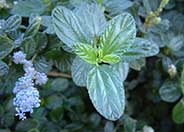
Common name:Yankee Point California Lilac
Botanical name:Ceanothus griseus hor. 'Yankee Point'
Yankee Point is a fast growing shrub that stays near 3' in height with a spread of 6'. It has large, bright green leaves and light blue flowers. It is great for banks and mass plantings. It does well on the coast and in hot inland areas. It attracts hummingbirds, butterflies and beneficial insects. -Cornflower Farms

Common name:California Sagebrush
Botanical name:Artemisia californica
The California sagebrush is an evergreen medium sized, gray green aromatic shrub. The foliage has wispy soft texture.This shrub is native to CA, is drought tolerant, and attracts butterflies. This is a highly combustible plant. ~Cornflower Farms

Common name:Woolly Blue Curls
Botanical name:Trichostema lanatum
The Woolly Blue Curls is an evergreen shrub that reaches 3'-5' high. It has an open branching habit and has long stalks of brilliant purple woolly flowers in the spring and summer. This shrub is native to California, is drought tolerant, and attracts hummingbirds. -Cornflower Farms

Common name:California Sycamore
Botanical name:Platanus racemosa
The California Sycamore is a fast growing deciduous tree that reaches up to 40'-50' high. It tolerates heat, smog, and drought conditions as well as moist conditions; it is native to riparian areas. It has interesting mottled bark when the tree is bare in winter.

Common name:Carmel Creeper
Botanical name:Ceanothus griseus horizontalis
Carmel Creeper is one of the most popular forms of spreading shrubs. Its glossy oval leaves of 2" are bright green. The tiny, light blue flowers are abundant and form 1" clusters. This shrub benefits from pruning. It does best in well-drained soil with little to no summer water.
Dealing With Drought
More than half of the water used at your home is for outside purposes. Studies show that on average, half of the water used outdoors is wasted. The leading cause of waste is incorrectly set and poorly managed irrigation controllers. The second biggest cause of wastage is broken irrigation equipment that goes undetected. There are a few basic things you can do to make a big difference in your water use.
Click in the green box for more information
| Designer: | Native View from Patio |
Photographer: GardenSoft |
Soils and Compost:
Physical weed control, including mulching, or hand removal protects the watershed from harmful chemicals.
Integrated Pest Management:
Attract, or buy beneficial insects such as ladybugs and lacewings to control pest outbreaks in your garden.

